
In Greek mythology, Andromache was the wife of Hector, daughter of Eetion, and sister to Podes. She was born and raised in the city of Cilician Thebe, over which her father ruled. The name means 'man battler' or 'fighter of men' or 'man fighter' or 'man's battle', from the Greek stem ἀνδρ- 'man' and μάχη 'battle'.

Troy is a 2004 epic historical war film directed by Wolfgang Petersen and written by David Benioff. Produced by units in Malta, Mexico and Britain's Shepperton Studios, the film features an ensemble cast led by Brad Pitt, Eric Bana, Sean Bean, Brian Cox, Brendan Gleeson and Orlando Bloom. It is loosely based on Homer's Iliad in its narration of the entire story of the decade-long Trojan War—condensed into little more than a couple of weeks, rather than just the quarrel between Achilles and Agamemnon in the ninth year. Achilles leads his Myrmidons along with the rest of the Greek army invading the historical city of Troy, defended by Hector's Trojan army. The end of the film is not taken from the Iliad, but rather from Quintus Smyrnaeus's Posthomerica, as the Iliad concludes with Hector's death and funeral.
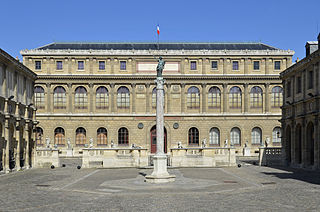
The Beaux-Arts de Paris, formally the École nationale supérieure des beaux-arts, is a French grande école whose primary mission is to provide high-level fine arts education and training. The art school, which is part of the Paris Sciences et Lettres University, is located on two sites: Saint-Germain-des-Prés in Paris, and Saint-Ouen.
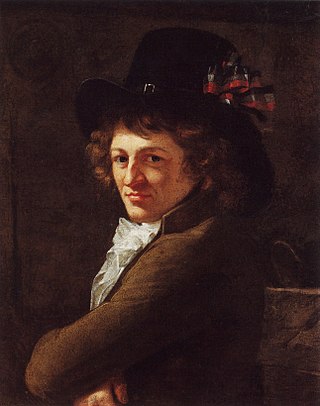
Eberhard Georg Friedrich von Wächter was a German painter. Wächter died in Stuttgart.

Oath of the Horatii is a large painting by the French artist Jacques-Louis David painted in 1784 and 1785 and now on display in the Louvre in Paris. The painting immediately became a huge success with critics and the public and remains one of the best-known paintings in the Neoclassical style.
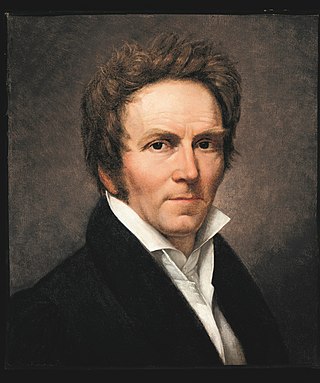
Johan Ludwig Gebhard Lund was a Danish painter, born in Kiel, Duchy of Holstein, to master painter Hans Giewert Lund and his wife Maria Magdalena Christina Bremer. An adherent of romanticism, he is known for his history paintings.
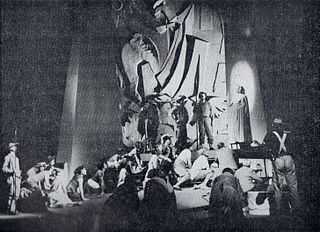
The Trojan War Will Not Take Place is a play written in 1935 by French dramatist Jean Giraudoux. In 1955 it was translated into English by Christopher Fry with the title Tiger at the Gates. The play has two acts and follows the convention of the classical unities.

Andromache is an Athenian tragedy by Euripides. It dramatises Andromache's life as a slave, years after the events of the Trojan War, and her conflict with her master's new wife, Hermione. The date of its first performance is unknown. Some scholars place the date sometime between 428 and 425 BC. Müller places it between 420 and 417 BC. A Byzantine scholion to the play suggests that its first production was staged outside Athens, though modern scholarship regards this claim as dubious.
King Priam is an opera by Michael Tippett, to his own libretto. The story is based on Homer's Iliad, except the birth and childhood of Paris, which are taken from the Fabulae of Hyginus.
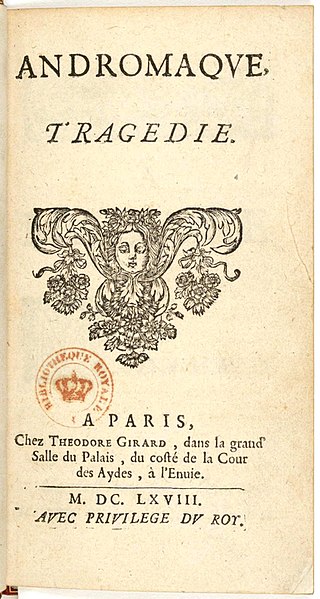
Andromaque is a tragedy in five acts by the French playwright Jean Racine written in alexandrine verse. It was first performed on 17 November 1667 before the court of Louis XIV in the Louvre in the private chambers of the Queen, Marie Thérèse, by the royal company of actors, called "les Grands Comédiens", with Thérèse Du Parc in the title role. The company gave the first public performance two days later in the Hôtel de Bourgogne in Paris. Andromaque, the third of Racine's plays, written at the age of 27, established its author's reputation as one of the great playwrights in France.

Pyotr Fyodorovich Sokolov was a Russian aquarelle portraitist who painted many of the most distinguished figures of the Pushkin era. He was the father of the painters Pyotr Sokolov, Pavel Sokolov and Alexander Sokolov.
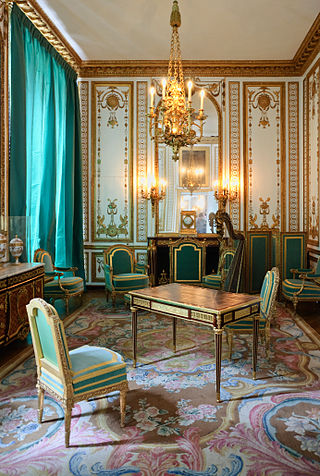
Louis XVI style, also called Louis Seize, is a style of architecture, furniture, decoration and art which developed in France during the 19-year reign of Louis XVI (1774–1793), just before the French Revolution. It saw the final phase of the Baroque style as well as the birth of French Neoclassicism. The style was a reaction against the elaborate ornament of the preceding Baroque period. It was inspired in part by the discoveries of Ancient Roman paintings, sculpture and architecture in Herculaneum and Pompeii. Its features included the straight column, the simplicity of the post-and-lintel, the architrave of the Greek temple. It also expressed the Rousseau-inspired values of returning to nature and the view of nature as an idealized and wild but still orderly and inherently worthy model for the arts to follow.

Sappho 44 is a fragment of a poem by the archaic Greek poet Sappho, which describes the wedding of Hector and Andromache. Preserved on a piece of papyrus found in Egypt, it is the longest of Sappho's surviving fragments, and is written in epic style suiting its subject. The metre is glyconic with double dactylic expansion.

Luncheon in the Studio is an 1868 oil painting by Édouard Manet. Partially a portrait of 16-year-old Léon Leenhoff — the son of Suzanne Leenhoff before her 1863 marriage to Manet, and possibly the son of Manet or Manet's father Auguste — it is also an enigmatic work that has received limited attention within Manet's oeuvre. Critic Nan Stalnaker notes that "despite continued questions about its meaning, the work is acknowledged to be brilliantly painted and a major Manet work".
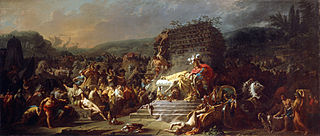
The Funeral Games of Patroclus is a 1778 oil-on-canvas painting by the French artist Jacques-Louis David. It shows the funeral games for Patroclus during Trojan War, with his body and Achilles at the foot of the pyre and Hector resting on his chariot on the right. It was first exhibited at the Palazzo Mancini in Rome in September 1778, where it was a critical success. It was then lost until 1972, when it was acquired by the National Gallery of Ireland, its present home.

The Vestal Virgin is an oil-on-canvas painting by the French artist Jacques-Louis David. Its date is unknown, but Antoine Schnapper estimates it between 1784 and 1787, 1787 being the year given for it in the 1803 Lespinasse sale catalogue. Sophie Monneret suggests 1783, the same year as Andromache Mourning Hector, perhaps in response to the creation of the Prix de Vertu.

Psyche Abandoned is a c. 1795 painting by Jacques-Louis David, now in a private collection. It shows Psyche as a crouching female nude in profile against a blue sky with a hill in the background. She stares at the viewer with an expression of loss, pain, and betrayal. Thought to have been painted during David's imprisonment during the French Revolution, it dates from either 1794 or 1795. Vertical in format, it diverges from the academic conventions for representing the female nude.

Marguerite-Charlotte David (1764–1826) was the French wife of the painter Jacques-Louis David.
Le Cygne is a poem by Baudelaire published in the section "Tableaux Parisiens" of Les Fleurs du mal.

Portrait of Alphonse Leroy is a 1783 oil-on-canvas portrait of doctor and man-midwife Alphonse Leroy by the French Neoclassical artist Jacques-Louis David. It is now in the Musée Fabre in Montpellier, which bought it in 1829.


















